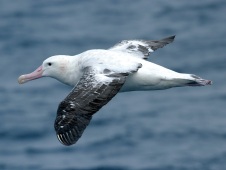
Albatrosses are long-lived, slow-breeding birds that form a remarkable lifelong bond with their mate. They dedicate months to the incubation and rearing process of their chicks and will lay a single egg every one or two years. For species like this even apparently slow population decline can lead to a high risk of extinction, and rapid decline can have drastic consequences.

For long-lived, slow-breeding birds, even apparently slow population declines can have alarming consequences if sustained. Two such species are the Wandering Albatross Diomedea exulans (total population 20,100 mature individuals) and Grey-headed Albatross Thalassarche chrysostoma (250,000), which both breed on islands in the southern oceans (Croxall and Gales 1998). At Bird Island (South Georgia), long-term monitoring studies have revealed steady declines of 1.8%, 2% and 4% per year respectively for these species over the last 20–30 years, caused by reduced survival of adults and, particularly in the last couple of decades, also of juveniles (Croxall et al. 1998, also British Antarctic Survey unpublished data, see figure). For Wandering Albatross, declines have been in the region of 4–5% since 1997.

These seemingly modest annual declines are highly significant, since albatrosses take many years to produce enough offspring to recuperate their population losses. These albatrosses may have generation lengths of up to 30 years, so the cited declines equate to population reductions of 30–65% over 65 to 90 years (i.e. three generations). Incidental mortality linked to longline and trawl fishing is the greatest threat to albatrosses. As these birds undertake fantastic migrations, they fly across broad stretches of the high seas and Exclusive Economic Zones of many countries. For example, the Wandering Albatross (pictured above) will fly from sub-tropical waters to the Antarctic, a journey that will take this species across 10,000km in less than three weeks. During these flights, albatrosses forage and are attracted to the baited hooks and fish waste of commercial fisheries. Overall, it is estimated that these global fishing fleets kill 100,000 albatrosses as bycatch every year. Because of these high rates of mortality and steady population decline, both albatrosses mentioned above are evaluated as globally threatened; despite still appearing numerous, they face a high risk of extinction if current trends continue.
Related Case Studies in other sections
Related Species
References
Croxall, J. P. and Gales, R. (1998) Pp. 46–65 in G. Robertson and R. Gales, eds. Albatross biology and conservation. Chipping Norton, Australia: Surrey Beatty & Sons.
Croxall, J. P., Prince, P. A., Rothery, P. and Wood, A. G. (1998) Pp. 69-83 in G. Robertson and R. Gales, eds. Albatross biology and conservation. Chipping Norton, Australia: Surrey Beatty & Sons. Also British Antarctic Survey unpublished data.
Compiled: 2004 Last updated: 2017
Recommended Citation:
BirdLife International (2017)
Many albatross species are in alarming slow decline.
Downloaded from https://datazone.birdlife.org/sowb/casestudy/many-albatross-species-are-in-alarming-slow-decline on 26/12/2024